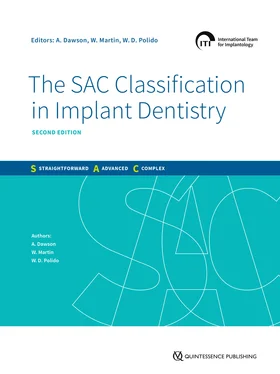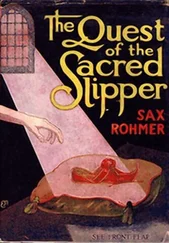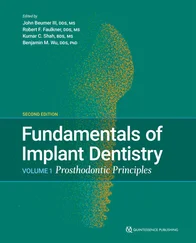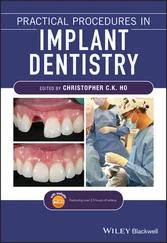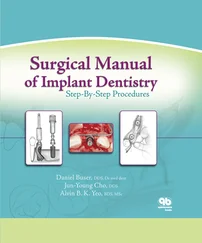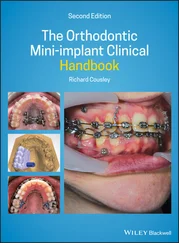3.3.1.1 Medical fitness
3.3.1.2 Medications
3.3.1.3 Radiation
3.3.1.4 Growth status
3.3.2 Patient attitudes/behaviors
3.3.2.1 Smoking habit
3.3.2.2 Compliance
3.3.2.3 Oral hygiene
3.3.2.4 Patient expectations
3.3.3 Site-related factors
3.3.3.1 Periodontal status
3.3.3.2 Access
3.3.3.3 Previous surgeries in the planned implant site
3.3.3.4 Nearby pathology
3.4 Esthetic Risk
W. MARTIN, V. CHAPPUIS, D. MORTON, D. BUSER
3.4.1 Medical status and smoking habit
3.4.2 Gingival display at full smile
3.4.3 Width of the edentulous space
3.4.4 Shapes of tooth crowns
3.4.5 Restorative status of adjacent teeth
3.4.6 Gingival phenotype
3.4.7 Volume of surrounding tissues
3.4.8 Patient’s esthetic expectations
3.5 Edentulous Esthetic Risk Assessment (EERA)
L. GONZAGA, W. MARTIN, D. MORTON
3.5.1 Facial support
3.5.2 Labial support
3.5.3 Upper lip length
3.5.4 Buccal corridor
3.5.5 Smile line
3.5.6 Maxillomandibular relationship
3.6 Surgical Risks
W. D. POLIDO
3.6.1 Anatomy
3.6.1.1 Bone volume – Horizontal
3.6.1.2 Bone volume – Vertical
3.6.1.3 Presence of keratinized tissue
3.6.1.4 Quality of soft tissues
3.6.1.5 Proximity to vital anatomical structures
3.6.2 Adjacent teeth
3.6.2.1 Papilla
3.6.2.2 Recession
3.6.2.3 Interproximal attachment
3.6.3 Extractions
3.6.3.1 Radicular morphology / interradicular bone
3.6.3.2 Alveolar and basal bone morphology
3.6.3.3 Socket walls
3.6.3.4 Thickness of facial wall
3.6.3.5 Anticipated residual defect after implant placement
3.6.3.6 Quality and quantity of soft tissues
3.6.4 Surgical complexity
3.6.4.1 Timing of placement
3.6.4.2 Grafting procedures
3.6.4.3 Number of implants
3.7 Prosthetic Risks
C. STILWELL, W. MARTIN
3.7.1 Restorative site factors
3.7.1.1 Prosthetic volume
3.7.1.2 Interocclusal space
3.7.1.3 Volume and characteristics of the edentulous ridge
3.7.2 Occlusal factors
3.7.2.1 Occlusal scheme
3.7.2.2 Involvement in occlusion
3.7.2.3 Occlusal parafunction
3.7.3 Complexity of process
3.7.3.1 Access
3.7.3.2 Interim prosthesis
3.7.3.3 Implant-supported provisional restoration
3.7.3.4 Number and location of implants
3.7.3.5 Loading protocols
3.7.4 Complicating factors
3.7.4.1 Biologic
3.7.4.2 Mechanical and technical
3.7.4.3 Maintenance
Chapter 4: How Does the SAC Assessment Tool Derive a Classification?
A. DAWSON, S. KELLER
4.1 Introduction
4.2 Definitions
4.3 Workflow
4.3.1 General risk assessment (GRA)
4.3.2 Esthetic risk assessment (ERA)
4.3.2.1 ERA
4.3.2.2 EERA
4.3.3 Surgical risk assessment (SRA) and surgical classification
4.3.4 Prosthodontic risk assessment (PRA) and prosthodontic classification
4.4 Calculating a Classification
4.4.1 Calculation mechanism
4.5 Testing the Algorithm
4.6 Presenting the Results
Chapter 5: Practical Application of the SAC Assessment Tool
W. MARTIN, A. DAWSON, W. D. POLIDO
5.1 Introduction
5.2 Implants for Restoration of Single-Tooth Spaces: Areas of Low Esthetic Risk
5.2.1 Mandibular molar
M. ROCCUZZO
5.2.2 Mandibular molar
L. GONZAGA
5.3 Implants for Restoration of Single-Tooth Spaces: Areas of High Esthetic Risk
5.3.1 Maxillary central incisor
L. GONZAGA, W. MARTIN
5.3.2 Maxillary lateral incisor
A. TREVIÑO SANTOS
5.4 Implants in Extraction Sockets: Single-Rooted Teeth
5.4.1 Maxillary central incisor
W. MARTIN, L. GONZAGA
5.4.2 Maxillary premolar
L. GONZAGA
5.5 Implants in Extraction Sockets: Multirooted Teeth
5.5.1 Maxillary first molar
P. CASENTINI
5.6 Implants for Restoration of Short Edentulous Spaces: Areas of Low Esthetic Risk
5.6.1 Adjacent maxillary premolars
S. CHEN, A. DICKINSON
5.7 Implants for Restoration of Short Edentulous Spaces: Areas of High Esthetic Risk
5.7.1 Adjacent maxillary incisors
P. CASENTINI, M. CHIAPASCO
5.8 Implants for Restoration of Long Edentulous Spaces: Areas of High Esthetic Risk
5.8.1 Maxillary lateral and central incisors
A. TREVIÑO SANTOS
5.9 Implants for Restoration of Long Edentulous Spaces: Removable Prostheses
5.9.1 Maxilla
C. STILWELL
5.10 Implants for Restoration of the Full Arch: Removable
5.10.1 Edentulous maxilla: Bar-supported overdenture:
WS. LIN, D. MORTON
5.10.2 Edentulous maxilla: Zygomatic implant bar-supported overdenture
W. D. POLIDO, WS. LIN
5.11 Implants for Restoration of the Full Arch: Fixed
5.11.1 Edentulous mandible: Fixed dental prosthesis
P. CASENTINI
5.11.2 Edentulous maxilla and mandible: Implant-supported all-ceramic fixed complete dentures
D. MORTON, WS. LIN, W. D. POLIDO
Chapter 6: Conclusion
A. DAWSON, W. MARTIN, W. D. POLIDO
Chapter 7: References
CHAPTER 1: Introduction to the Updated SAC Classification
A. DAWSON, W. MARTIN, W. D. POLIDO
Implant dentistry is an integral part of modern dental practice, providing a strong evidence-based option for the rehabilitation of partially and completely edentulous patients. Clinical and technologic advancements in this field have increased the level of confidence that clinicians have in this form of therapy and have also led to a broader base of incorporation into daily practice. What was once the domain of specialist practice is now a common treatment modality in many, if not most, general practices. This has increased the need for all clinicians involved with the field of implant dentistry, irrespective of specialty, to be able to provide therapy at an appropriate level of care.
It has long been recognized that clinical situations present with different levels of difficulty and with different degrees of risk for esthetic, restorative, and surgical complications. Despite the advances in knowledge and improved techniques, implant dentistry is not free from risks of complications or suboptimal outcomes. Over the last decade, research in this field has increasingly provided information regarding the risks associated with this treatment option. The successful osseointegration of an implant is no longer the primary focus of treatment. Rather, the range of potential problems with implants and their related prostheses has come into sharper focus. It is in this environment that the SAC classification has evolved to assist practitioners in recognizing risk factors and providing appropriate levels of care.
1.2 Historical Background
The concept of assessing risk factors in implant dentistry has attracted considerable attention since the early 1990s, when the number of clinicians placing and restoring implants increased significantly. With this increase in use, the number of associated complications also increased.
Renouard and Rangert (1999) published a classification system that addressed the risk factors involved with the surgical and restorative phases of implant rehabilitation. At that time, they affirmed that some risk factors are relative, while others are absolute. The distinction between the two is not as clear as it might appear. However, several relative contraindications or one absolute contraindication should lead to a reevaluation of the original treatment plan. Although they were using terms like “OK,” “Caution,” and “Danger,” and using the green, yellow, and red colors associated with increased risk factors, an integrated decision tree was not present.
Читать дальше
